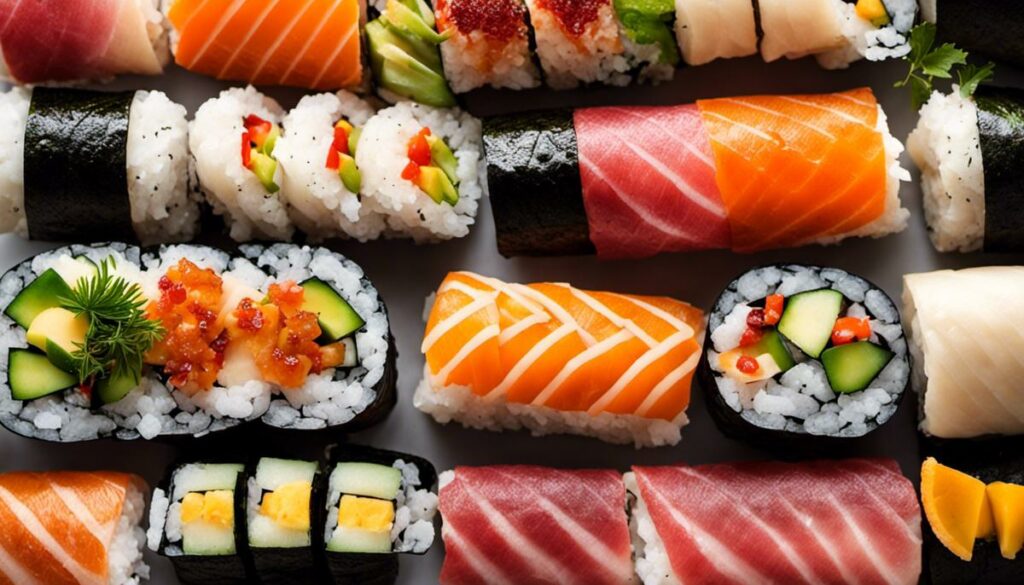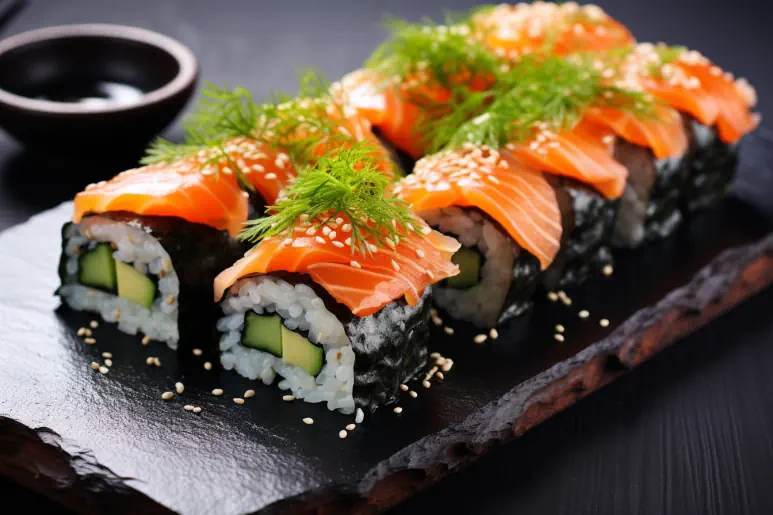The world of gastronomy is full of discoveries, of which the fascinating journey of the dragon roll – an elaborately prepared sushi variant – reveals a wide range of flavor compositions, techniques and traditions. This Japanese specialty has evolved from the finesse of the traditional art of sushi and claims its uniqueness in both the culinary and cultural landscape. The Dragon Roll Sushi, with its carefully selected ingredients and impressive exterior, presents an unparalleled symphony of flavors, techniques, traditions and stories that will invoke a fascination in every sushi lover and novice.
A) What is Dragon Roll Sushi?
Among the numerous sushi variants, the dragon roll stands out for its unique combination of flavors and sight. It is not only a feast for the eyes, but also an unforgettable culinary experience. Its uniqueness is defined by four main features: the unique technique of preparation, the ingredients used, the evocative design and the sensory taste experience.
In terms of preparation, the “inside-out” technique, or Uramaki style, is used in the dragon roll. Unlike the traditional maki roll, where the seaweed is on the outside and the rice on the inside, the dragon roll is the other way around. The rice is on the outside and the seaweed is on the inside. This reversal gives the dragon roll a special texture and a more pronounced rice note.
The choice of ingredients is equally characteristic. The dragon roll usually contains creamy eel meat, crunchy cucumber, sweet avocado and often shrimp or crab meat. However, variations may vary by region or restaurant. A real taste highlight is the Unagi sauce, a sweet and slightly smoky eel sauce that perfectly complements the taste of the eel meat.
Visually, the dragon roll scores with its elaborate and colorful appearance. It is often covered with avocado slices, which are supposed to represent the scales of the dragon. Some sushi chefs even add “eyes” made from fish eggs or carrots to make the dragon design stand out. Each dragon roll is a small work of art and a visual delight.
In conclusion, the sensory taste experience offered by the dragon roll is incomparable. The contrasting textures – the creamy eel flesh, the crunchy vegetables, the soft avocado topping and the light crunch of the outer rice – create a harmonious interplay that is rounded off by the sweetness and smokiness of the unagi sauce.
So the dragon roll isn’t just sushi; it is a true explosion of flavours, a feast for the senses and a jewel in the world of sushi. It’s a testament to how creative and multi-layered sushi cuisine can be. The dragon roll knows how to awaken the joy of eating and thus offers the opportunity to discover new culinary worlds – a culinary experience that will be remembered.
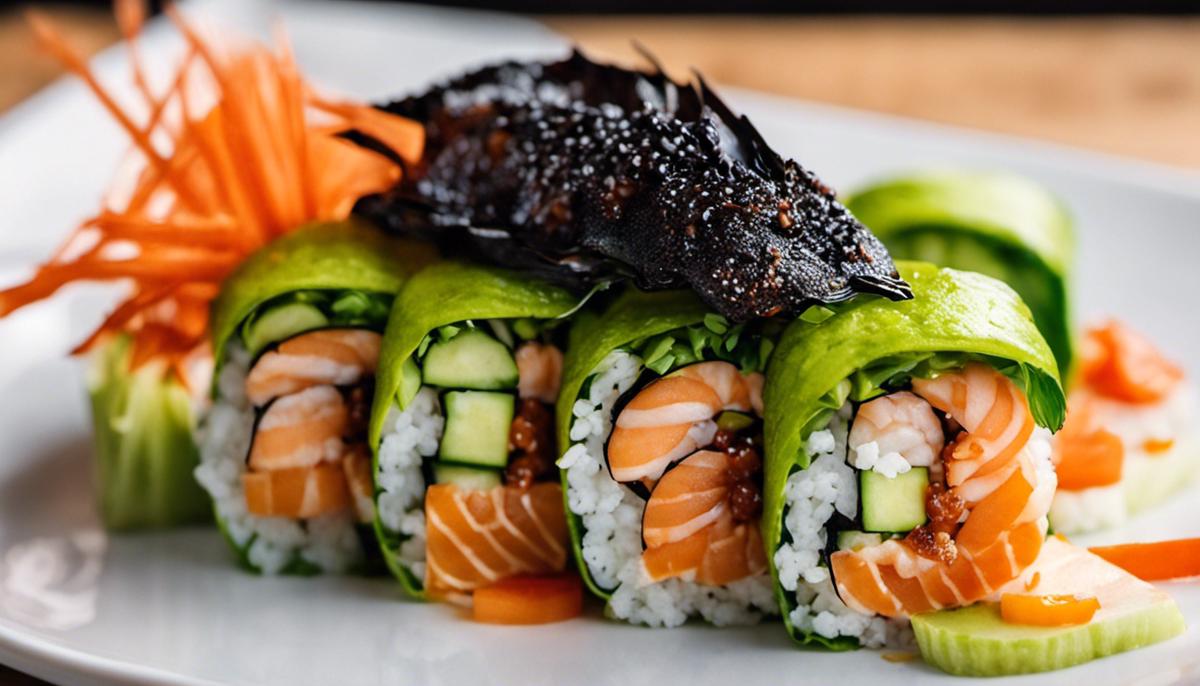
B) Sushi Techniques and Dragon Roll
An enthusiasm for food doesn’t have to stop at national borders. On the contrary, the desire to taste and explore new culinary worlds always draws us to distant kitchens and dining rooms, where unknown taste explosions await us. This is exactly where sushi and especially the diverse dragon roll come into play.
Their production is an art in itself and closely related to traditional sushi techniques. But how exactly?
The basic techniques of sushi preparation provide the basis for the preparation of the dragon roll. It starts with the right rice. For sushi, a short-grained, somewhat sticky rice is used, which is ideally easy to shape. The rice water ratio is crucial here and the cooking method follows old traditions. Very important: the rice is seasoned with a mixture of rice vinegar, sugar and salt after cooking.
The next step, rolling, is also closely related to traditional sushi techniques. The kite roll is made using a bamboo rolling mat for shaping. But unlike some other sushi shapes, here the nori seaweed sheet is placed on the inside of the rice – a clear connection to the Uramaki technique.
Tradition also comes into play when topping this form of sushi: the choice of ingredients is based on the combinations common in traditional Japanese cuisine. Eel and avocado are typical for the dragon roll, but there is also room for variation here – in the sense of the culinary variety that sushi generally offers.
Sushi is, of course, a very visually-oriented dish: the presentation on the plate is essential. The dragon roll, with its avocado scales, creates a strong visual appeal. This attention to appearance goes hand in hand with the traditional idea that sushi should not only taste good, but also be visually appealing.
And last but not least, it is the experience of consumption itself that combines the traditional sushi techniques with the preparation of the dragon roll. The process, how to cut the roll into parts, take it with your fingers, dip it in the soy sauce and finally end up in your mouth with a bite, reflects the original method of eating sushi.
Dragon roll embodies the true spirit of sushi cuisine: tradition mixed with creativity and passion, which can be tasted in every bite. It’s a delicious example of how time-honored techniques, modern presentation and inventive compositions can come together for an unforgettable culinary experience.
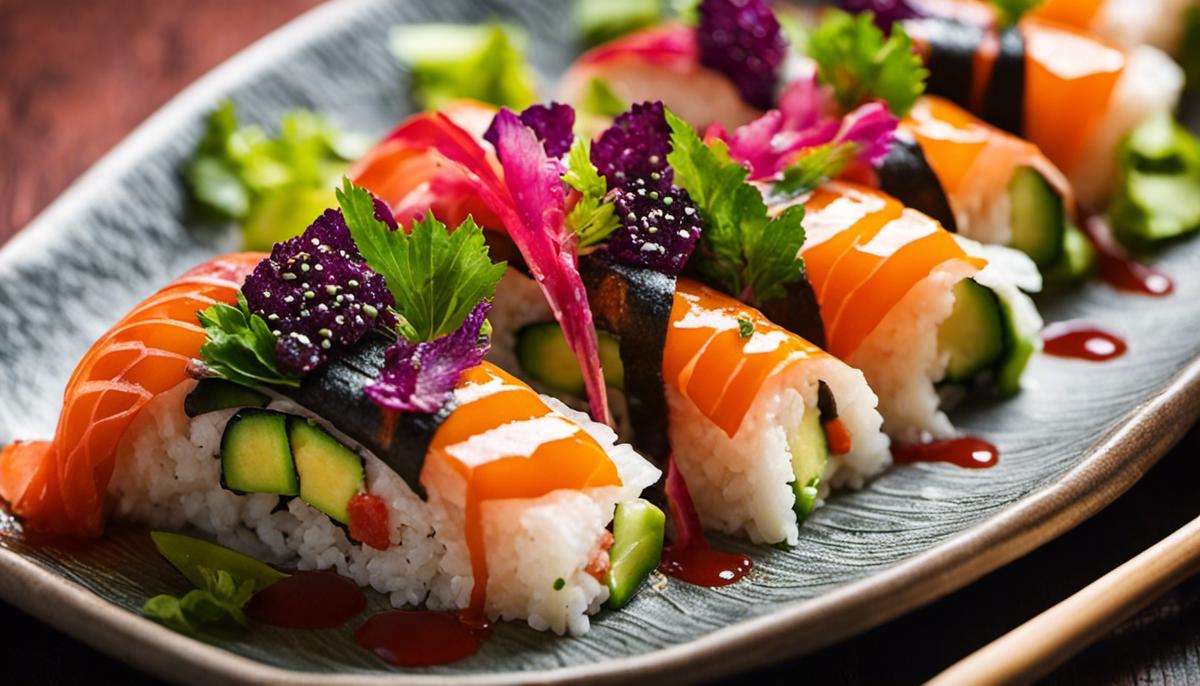
C) Ingredients and exotic flavors
Before we get into the pleasurable nuances of the dragon roll, it’s worth taking a brief look at the philosophy behind this culinary gem. It’s not just a fancy dish in a trendy sushi restaurant. And it’s not just a treat for those of us who have a serious soft spot for soft avocados, crunchy as well as juicy ingredients. Rather, the dragon roll is a symbol of a way of life and love of food culture that knows no boundaries.
By fusing ingredients from different cultures, a dish is created that arouses joy and curiosity and takes us on a culinary journey to distant regions of the world. Sushi and especially the dragon roll show us in a delicious way that there is always something new to discover.
Another aspect that makes the dragon roll so impressive is the traditional sushi techniques used to make it. This starts with the basics: the rice must be cooked to perfection and infused with a finely tuned mixture of rice vinegar. When rolling with the bamboo mat and placing the nori seaweed sheet, sensitivity is required.
But the way the role is documented also follows a certain theory of harmony: the selection of ingredients is based on traditional combinations, which are considered proven pairings. However, surprising aromas can also emerge that refine and deepen the sensory experience.
The visual arrangement also plays a role that should not be underestimated. The dragon roll is often decorated with avocado scales, which are fascinatingly reminiscent of the scales of a dragon. This attention to detail gives the reel the finishing touch and makes it a little feast for the eyes before the actual enjoyment.
Eating it is an experience for all the senses: First, the roll is cut into slices, which reveal the colourful composition inside. This is followed by immersion in a harmoniously balanced soy sauce. And finally – eating with your fingers, a sensory experience that pays tribute to the tactile aspect of the sushi tradition.
In all these steps from preparation to enjoyment, it is evident that the dragon roll is deeply rooted in the tradition of sushi techniques. The dragon roll embodies the spirit of sushi cuisine in all its diversity: a finely balanced balance between tradition and creativity, paired with a deep-rooted passion for good food. It is a dish that turns our food into an emotional and sensory experience – a heartfelt declaration of love to the diversity of global food culture.
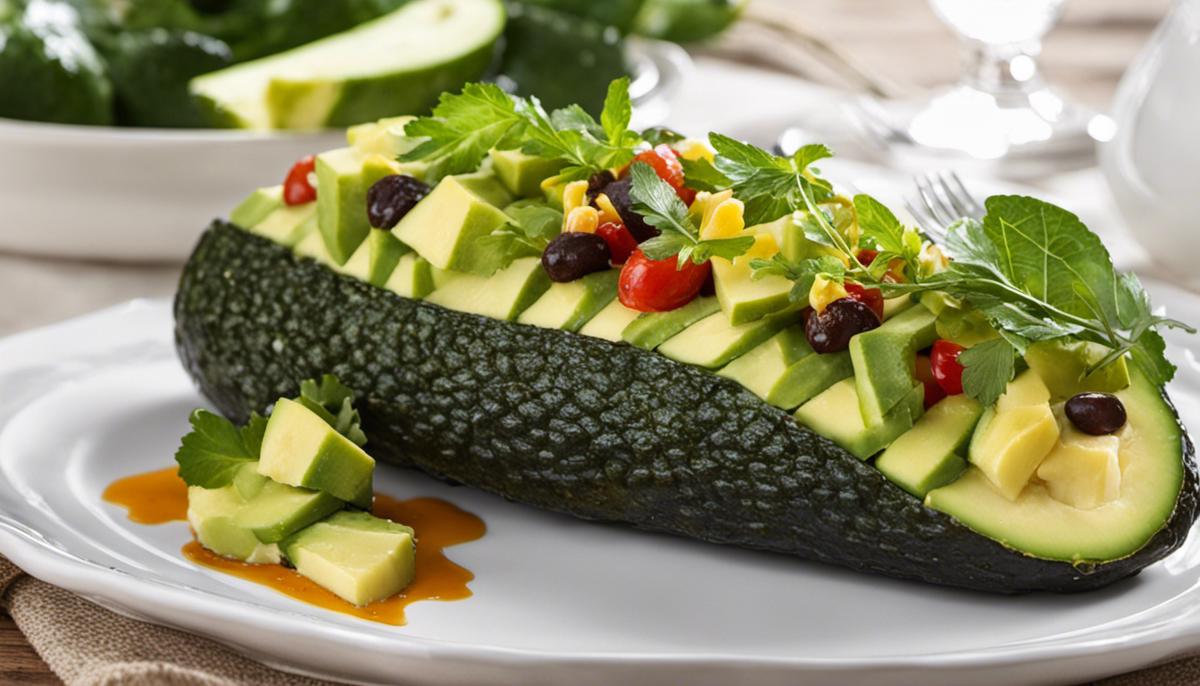
D) The Cultural Significance of Dragon Roll
The magical eating culture of the dragon roll goes far beyond the use of ingredients such as creamy eel, crispy cucumber, sweet avocado, and sometimes shrimp or crab. It is a personal invitation to embark on a journey of sensory experiences and at the same time to walk in the footsteps of Japanese cuisine.
The careful composition of the ingredients, the handling of the rolls with a bamboo mat, and the placement of the nori seaweed sheet represent the core of the sushi making process. But the kite roll expands this practice with variants and innovations. The combination of ingredients continues to be based on traditional values and patterns, but has evolved into a culinary representation of creativity and dynamism that is gaining wider resonance in global food culture.
Named for the ornate appearance of her delicious body, reminiscent of an Asian dragon, the dragon scroll creates a living masterpiece of culinary craftsmanship. While some admire them for their appearance, others are enchanted by the pleasure of the sensory experience, which is filled with the view of the colorful ensemble to the touch of soy sauce and the taste of a bite.
Embedding the dragon scroll in global food culture is a compelling testament to how a niche art can influence consumer habits worldwide. It has conquered the world, offering a unique sensory experience that combines taste, texture, sight and tradition. More than just a type of sushi, the dragon roll is a symbol of gastronomic exploration, a tribute to the fusion of cultures and a vision of the inexhaustible possibilities of creative culinary art.
The manufacturing technique is as important as the components themselves. The rice must be cooked to perfection, the rice vinegar mix plays a crucial role in flavor and texture, and the art of decorating, often with avocado scales, is a visual experience.
Eating the dragon roll is a multi-sensory experience and allows us to see through the eyes of a true foodie, full of fascination for the magic of pleasure. It is a declaration of love to food culture that knows no borders, sees food as a global glue between people and in this sense, the dragon role embodies the spirit and philosophy of global food culture in the most brilliant way. It’s not just about eating something, it’s more about feeling, smelling, seeing, and tasting the experience.
The dragon scroll reminds us that food is more than just food – it’s an act of connection, an expression of life, and an adventure in itself. It invites us to embark on a journey that allows us to discover and experience the magic of flavours, colours and textures. It is, in the truest sense of the word, a celebration of food that leaves an unforgettable impression on the general food culture. Food can be art. Food can be an adventure. Food can be family. In a dragon scroll, all these facets merge into a delicious culinary experience that is at once a tribute to tradition and a testament to the beauty of global food culture.
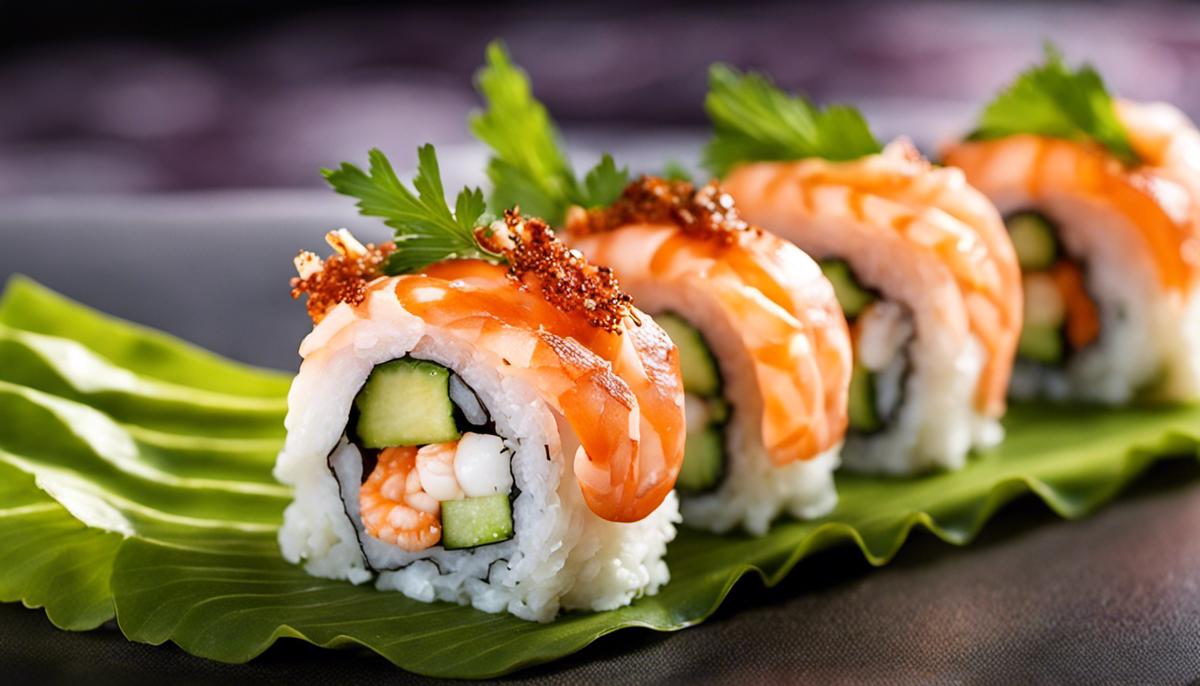
The subtle complexity of the dragon scroll evokes a keen sense of how the combination of raw materials, craftsmanship and tradition can create an enduring culinary icon. No discussion of sushi would be complete without recognizing the influence of this impressive presentation, its unique flavor, and its constant global distribution. The dragon roll is a perfect example of how food satisfies both our taste buds and our cultural appreciation of diverse cuisines. The remarkable rise of dragon roll sushi from its roots in traditional Japanese cuisine to its global popularity and recognition is a testament to the seductive power of culinary fusion and the elemental pleasure that food offers us.
